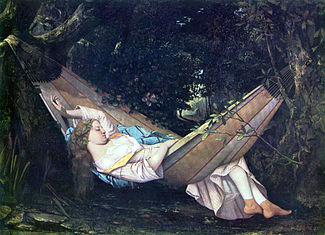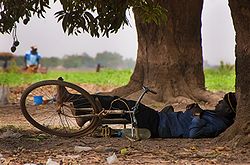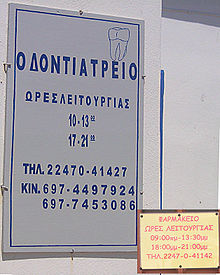- Siesta
-
A siesta (Spanish pronunciation: [ˈsjesta]) is a short nap taken in the early afternoon, often after the midday meal. Such a period of sleep is a common tradition in some countries, particularly those where the weather is warm.
Since the siesta is the traditional daytime sleep of Spain, and through Spanish influence, of many Latin American countries and in the Philippines, the word siesta has been taken from Spanish, from the Latin hora sexta – "the sixth hour" (counting from dawn, therefore noon, hence "midday rest"). Einhard's Life of Charlemagne recounts the emperor's summertime siesta: "In summer, after his midday meal, he would eat some fruit and take another drink; then he would remove his shoes and undress completely, just as he did at night, and rest for two or three hours."[1]
Factors explaining the geographical distribution of the modern siesta are mainly high temperatures and heavy intake of food at the midday main meal. Combined, these two factors contribute to the feeling of post-lunch drowsiness. In these countries, the heat can be unbearable in the early afternoon, making a midday break at home ideal. In many areas with this habit, it is common to have the largest meal of the day in the very early afternoon, as is practical and common in cultures dominated by agriculture.[citation needed]
The original concept of a siesta seems to have been merely that of a midday break intended to allow people to spend time with their friends and family. It has been suggested that the long length of the modern siesta dates back to the Spanish Civil War, when poverty resulted in many Spaniards working multiple jobs at irregular hours, pushing back meals to later in the afternoon and evening.[2] However, this hypothesis sounds unlikely, considering that the siesta tradition was very common in Latin America and other countries with Hispanic influence, much before the Spanish Civil War.[citation needed]
Contents
Protection from the sun
A siesta takes place when the sun is at its highest point. This is when the sun's ultraviolet radiation is at its peak at midday. Prolonged exposure to ultraviolet radiation may result in sunburn, especially if one has fair skin. Recurring overexposure to ultraviolet radiation can cause some forms of skin cancer.
The sun's infrared radiation causes high air temperatures from the midday onwards, the highest temperatures taking place in the early afternoon. High temperatures can cause fatigue or in more serious cases heat exhaustion , hyperthermia (sunstroke) and death.
Biological need for naps
Older, pre-teenage children are usually capable of napping, but acquire the ability to nap as teenagers as well.[3]
The timing of sleep in humans depends upon a balance between homeostatic sleep propensity, the need for sleep as a function of the amount of time elapsed since the last adequate sleep episode, and circadian rhythms which determine the ideal timing of a correctly structured and restorative sleep episode. The homeostatic pressure to sleep starts growing upon awakening. The circadian signal for wakefulness starts building in the (late) afternoon. As Harvard professor of sleep medicine Charles A. Czeisler notes, "The circadian system is set up in a beautiful way to override the homeostatic drive for sleep."[4]
Thus, in many people, there is a dip when the drive for sleep has been building for hours and the drive for wakefulness has not yet started. This is, again quoting Czeisler, "a great time for a nap."[4] The drive for wakefulness intensifies through the evening, making it difficult to get to sleep 2–3 hours before one's usual bedtime when the wake maintenance zone ends.
In some individuals, "postprandial dip", a brief drop in blood glucose levels caused by the body's normal insulin response to a heavy meal, may produce drowsiness after the meal that can encourage a nap. However, the appearance of the dip is primarily circadian as it occurs also in the absence of the meal.
Siesta in other cultures
The concept of a midday nap is also prominent in other tropical or subtropical countries, where the afternoon heat dramatically reduces work productivity. The Washington Post of February 13, 2007 reports at length on studies in Greece that indicate that those who nap have less risk of heart attack.[5]
An example of a siesta-like habit can be found in Serbia and Slovenia. Especially among older citizens, it is common to observe the so-called "house rule", requiring people to refrain from telephoning or visiting each other between 2 p.m. and 5 p.m., as people are supposed to be resting; especially since lunch in Serbia and Slovenia, eaten usually between 1 p.m. and 2 p.m., is the main dish of the day. In some southern German-speaking regions, the Mittagspause (de:Mittagspause) or Mittagsruhe (de:Mittagsruhe) is still customary; shops close, and children are expected to play quietly indoors.
In South Asia, the idea of a post-lunch nap is common, and the idea of going to sleep after a light massage with mustard oil to induce drowsiness was very popular before industrialization. It was also very popular to consume a light snack during this ritual; it was thought that this practice would make one a better person.[citation needed] In Bengal, the word which describes the concept is bhat-ghum, literally meaning "rice-sleep", a nap after lunch. In north India a colloquial term sustānā (सुस्ताना), which literally means "taking small nap" (possibly of Persian origin), is used, although it does not necessarily mean siesta but it is used in same way. According ayurveda vamkukshi (nap in the afternoon) for 15-30 minutes after lunch is good for your health, it does not mean deep sleep but just lying down.
Afternoon sleep is also a common habit in China and Taiwan after the midday meal. This is called wujiao (午覺) in Chinese. Almost all schools in Mainland China and Taiwan have a half-hour nap period right after lunch. This is a time when all lights are out and one is not allowed to do anything other than rest or sleep.
Some Japanese offices have special rooms known as napping rooms for their workers to take a nap during lunch break or after overtime work.
In Islam, it is encouraged to take a nap before Dhuhr (midday) , for those doing tahajjud later in the night.[original research?]
In the United States, the United Kingdom, and a growing number of other countries, a short sleep has been referred to as a "power nap", a term coined by Cornell University social psychologist James Maas[6] and recognized by other research scientists such as Sara Mednick[7] as well as in the popular press.[8]
References
- ^ Einhard, Life of Charlemagne, §24.
- ^ Anderson, John Ward and Jennifer Green. "Shaking Spain Out of Its Siesta", Washington Post, April 23, 2006, p. A12.
- ^ Dement, William (1999). The Promise of Sleep. Dell Publishing. pp. 113–115. ISBN 0-440-50901-7.
- ^ a b Lambert, Craig, PhD (July–August 2005). "Deep into Sleep. While researchers probe sleep's functions, sleep itself is becoming a lost art". Harvard Magazine. http://harvardmagazine.com/2005/07/deep-into-sleep.html. Retrieved 2008-02-25.
- ^ Stein, Rob. "Midday Naps Found to Help Fend Off Heart Disease", Washington Post, 13 February 2007, p. A14.
- ^ Maas, James B. (1998) Miracle Sleep Cure: London: Thorsons
- ^ "The National Institute of Mental Health Power Nap Study". 2002-07-01. http://www.nih.gov/news/pr/jul2002/nimh-02.htm. Retrieved 2002-07-01.
- ^ "Researchers: Power Nap Better than Caffeine to Fight Afternoon Fatigue". Fox News. 2007-09-04. http://www.foxnews.com/story/0,2933,295677,00.html.
External links
- Why we could all do with a Siesta – An article about research results from the University of Manchester
- Indian ways of chilling peak summer noon hours
Categories:- Sleep
- Spanish loanwords
Wikimedia Foundation. 2010.



